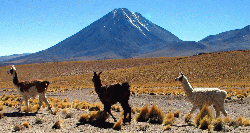Central Andean Tectonic Observatory (CAnTO) Project
CAnTO Home | People | GPS/InSAR | PeruSE | Publications | Relevant Links

Llamas in Chile
|
This collaborative project focuses on the dynamics of the South American subduction zone, a region producing a high percentage of the world's largest earthquakes and tsunamis, hundreds of active volcanoes, and the continually rising Andean mountain range.
Our focus is the central Andean segment, where an earthquake with magnitude greater than 8.5 is expected in the next few decades. The last significant earthquakes here were in 1868 and 1877, both of which caused tsunamis.
We seek to understand how variations in seismic and aseismic behavior affect the longer-term geologic evolution of the forearc.
We are also searching for aseismic transient slip events (i.e., movement of the two plates that does not build up enough strain to produce earthquakes). In terms of longer time scale processes, we seek to understand the underlying cause of flat subduction.
We use GPS stations, seismographs, and field geology to monitor the process of strain accumulation along the plate interface, which leads to large earthquakes along the subduction zone.
Our activities include:
- Geodetic monitoring (GPS and InSAR) - These data measure the motion of the earth's crust and are used to measure the distribution of present-day crustal strain and its time-dependence (more info)
- Seismologic analysis - Signals detected by seismometers tell us not only about the location and size of earthquakes, but also illuminate the structure of the earth's interior through which the seismic waves travel. We use them to determine the geometry of the plate boundary interface, three-dimensional variations of material properties, and characteristics of regional earthquakes (more info)
- Three-dimensional continuum modeling to test our hypotheses and provide physically based links across time scales - from earthquake ruptures (in seconds) to building mountain ranges (in millions of years), as well as the controls on subduction dynamics.
Contacts: Mark Simons and Rob Clayton |

